Abstract
Correlations in age at onset between relatives affect risk to relatives of a given age. Either an increase or a decrease in risk may be observed for a relative of a proband, according to whether there is a causal relationship between liability to disease and age at onset. Likelihood formulas are given for pairs of relatives under a number of different sampling schemes, and it is shown how data collected from relatives enable maximum-likelihood estimation of parameters of a linear model relating disease liability and age at onset. A genotype-environment extension of this model was fitted to data on age at onset for schizophrenia that were obtained from the National Academy of Sciences-National Research Council Twin Registry. Age at onset is correlated between twins, but this correlation appears to be associated with factors that are separate from those which affect liability to disease. However, even this relatively large sample of twins is too small to draw firm conclusions about any causal relationship between disease liability and onset.
Full text
PDF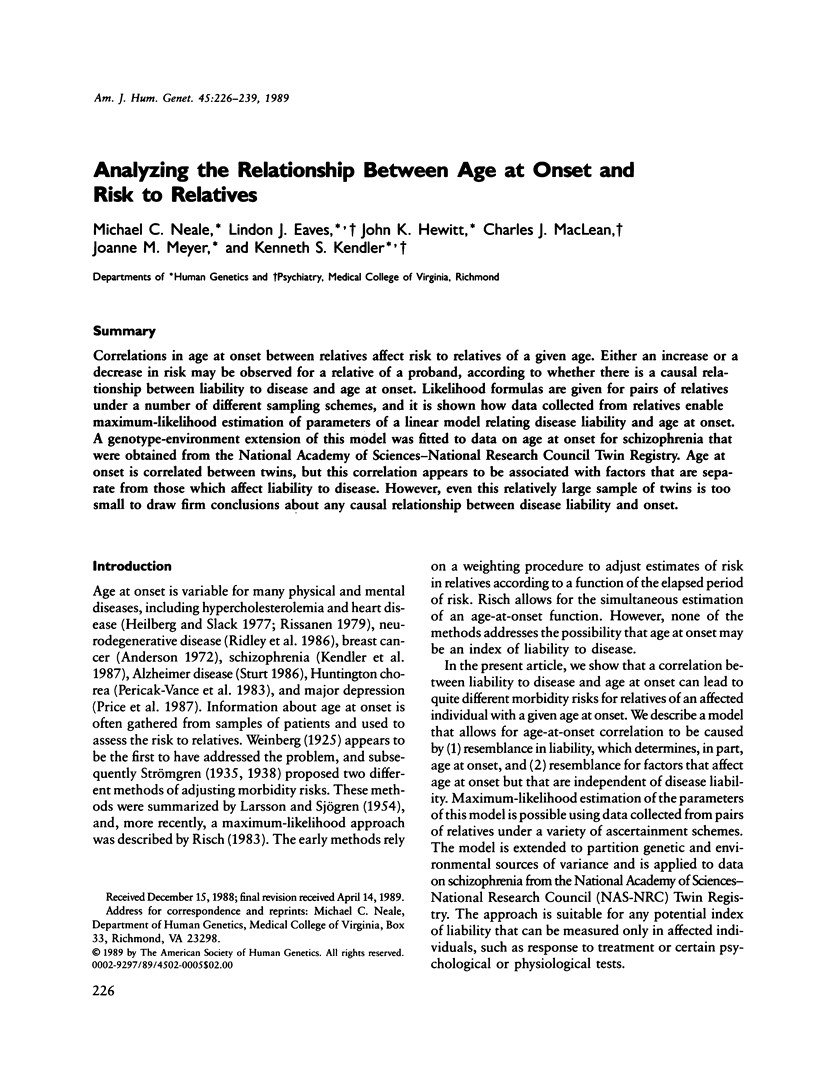
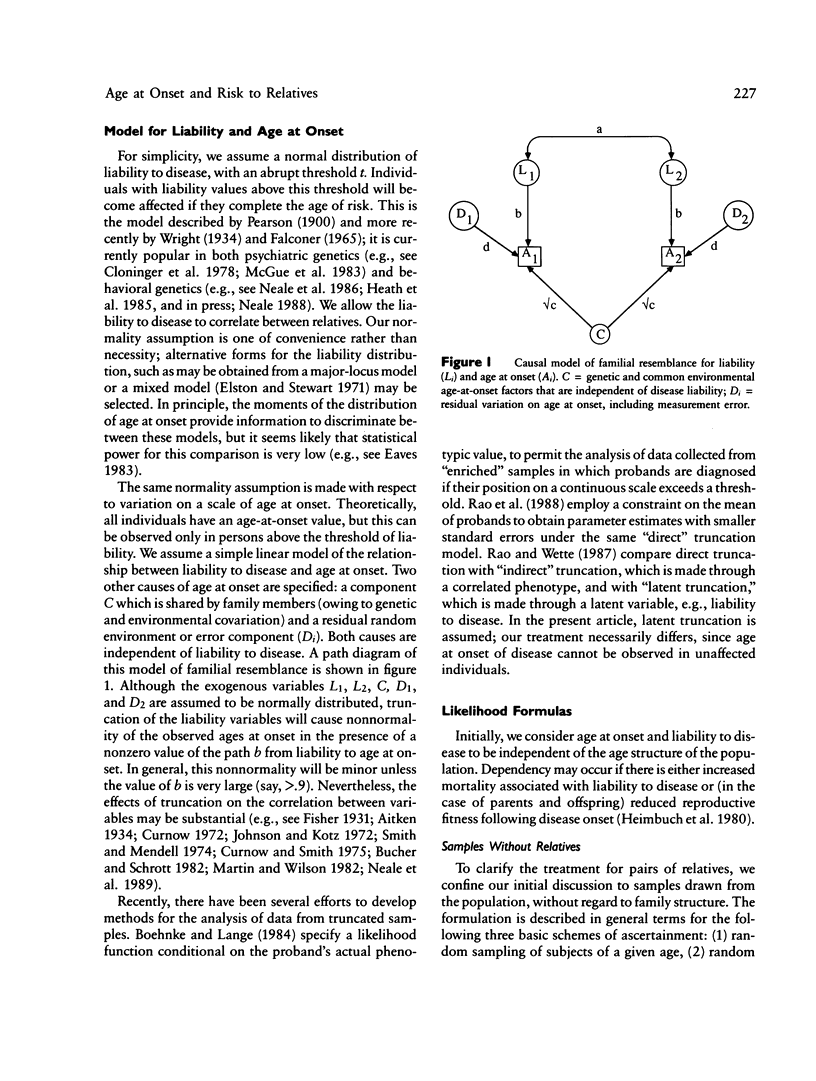
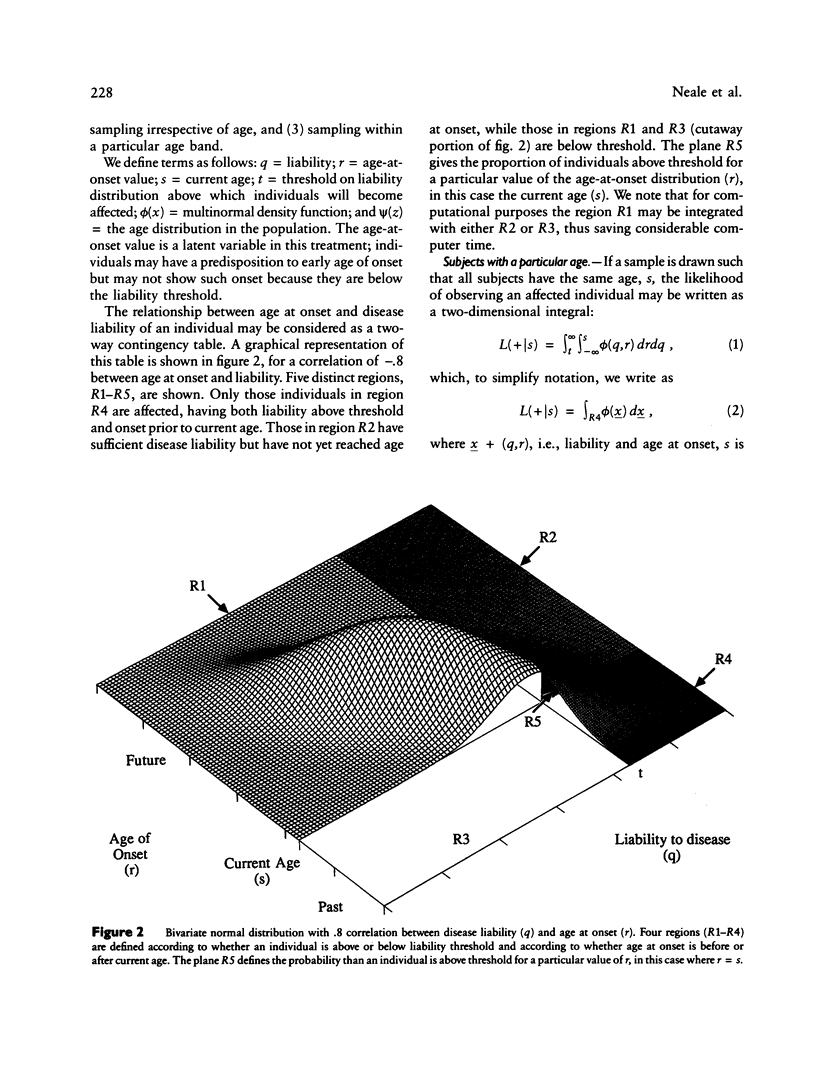
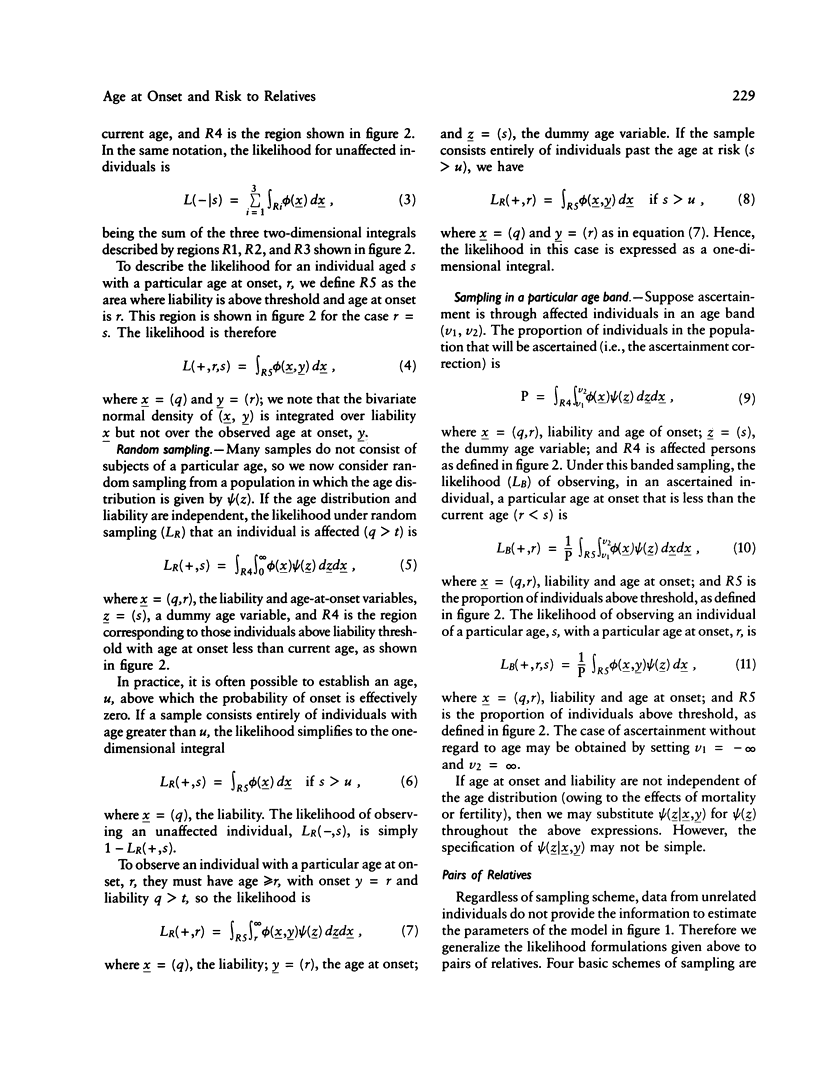
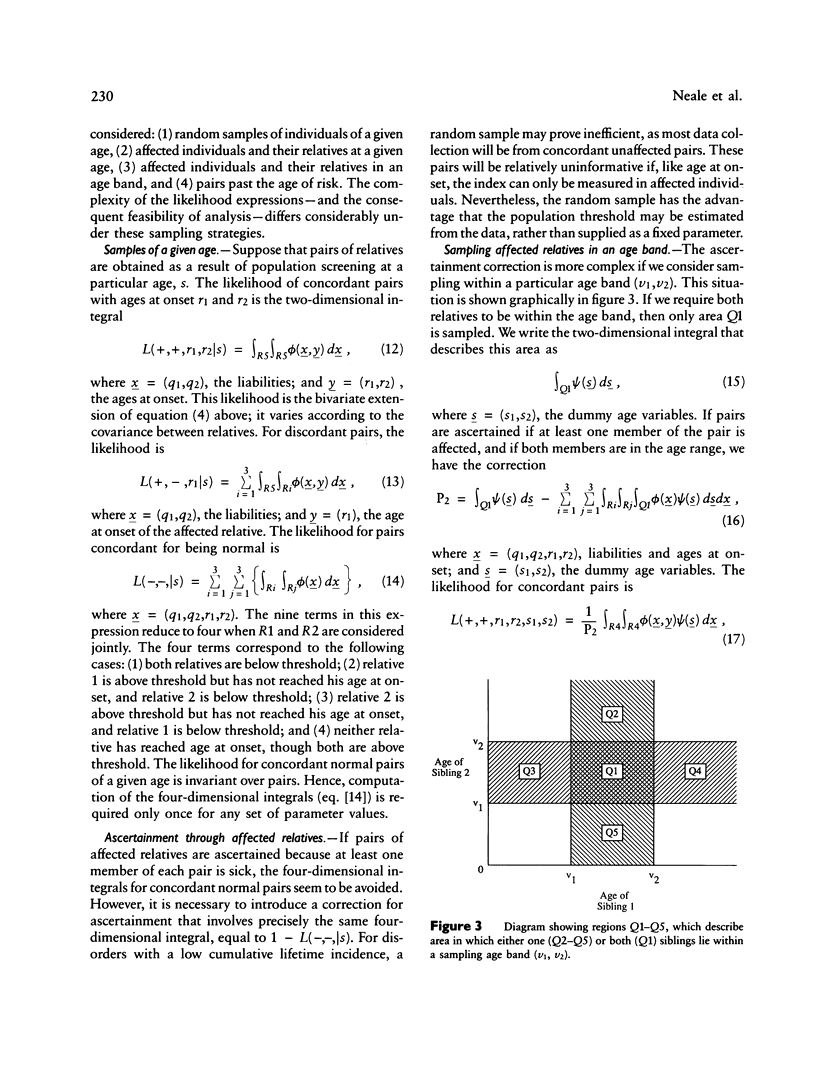
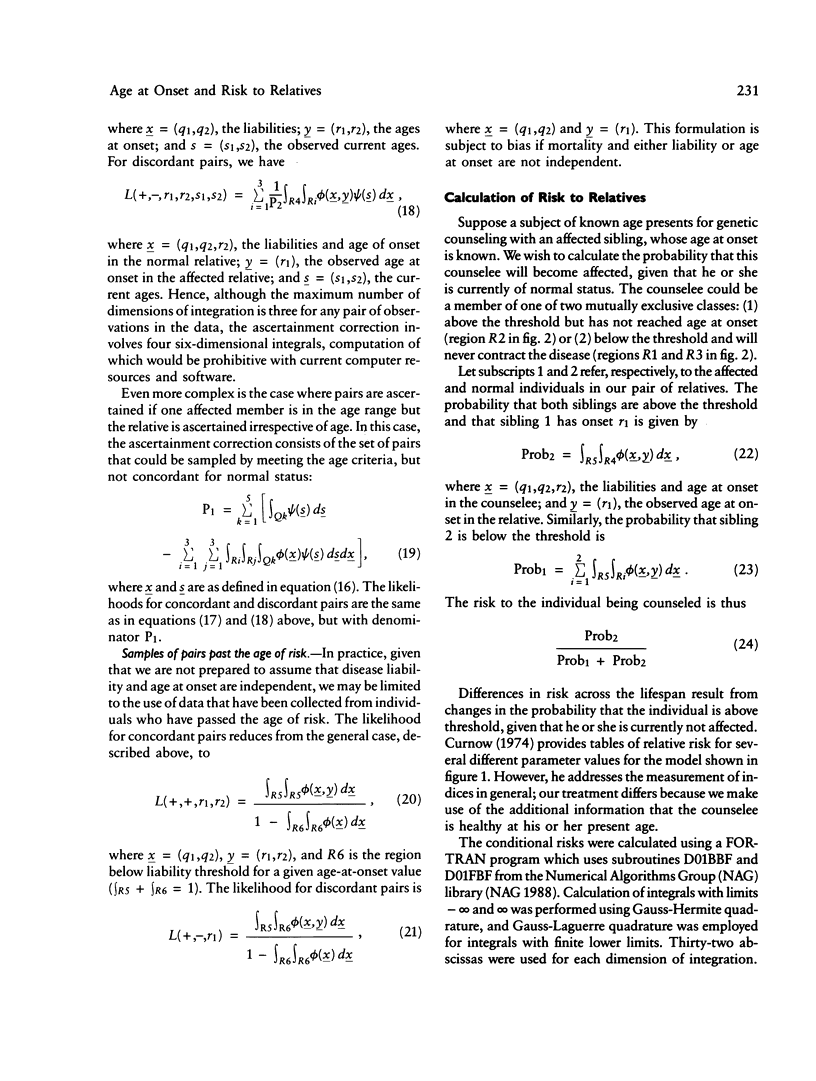
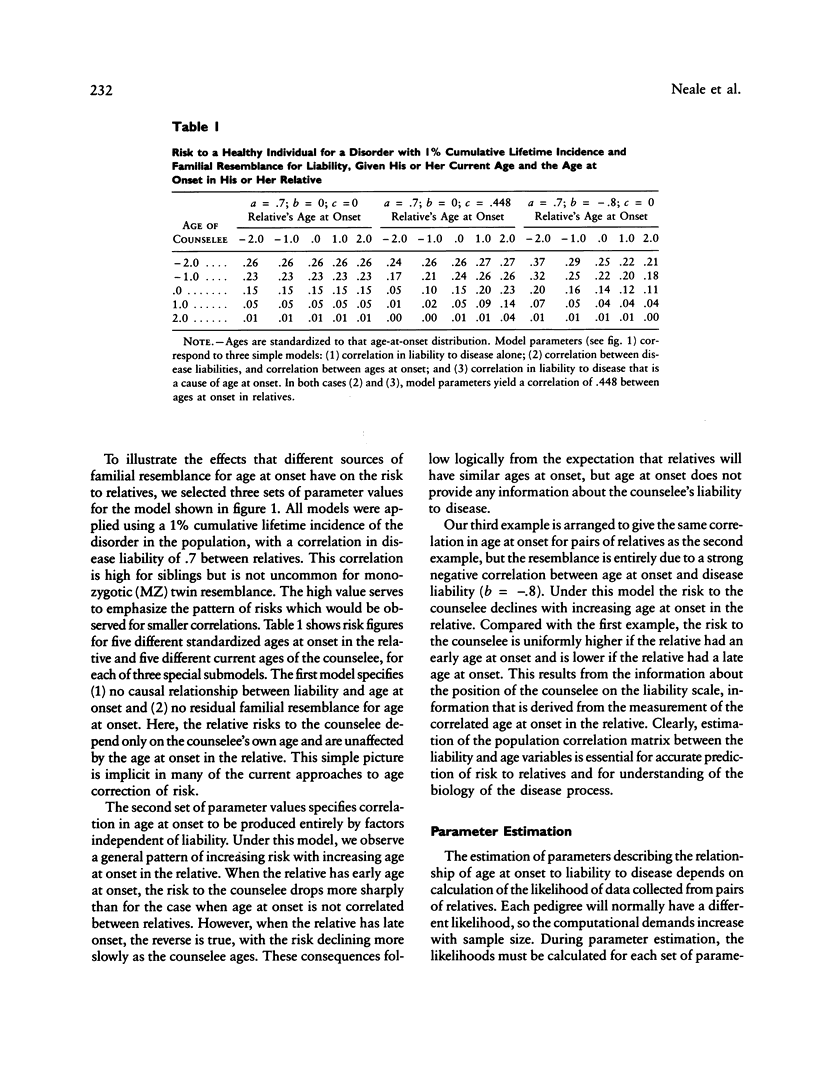
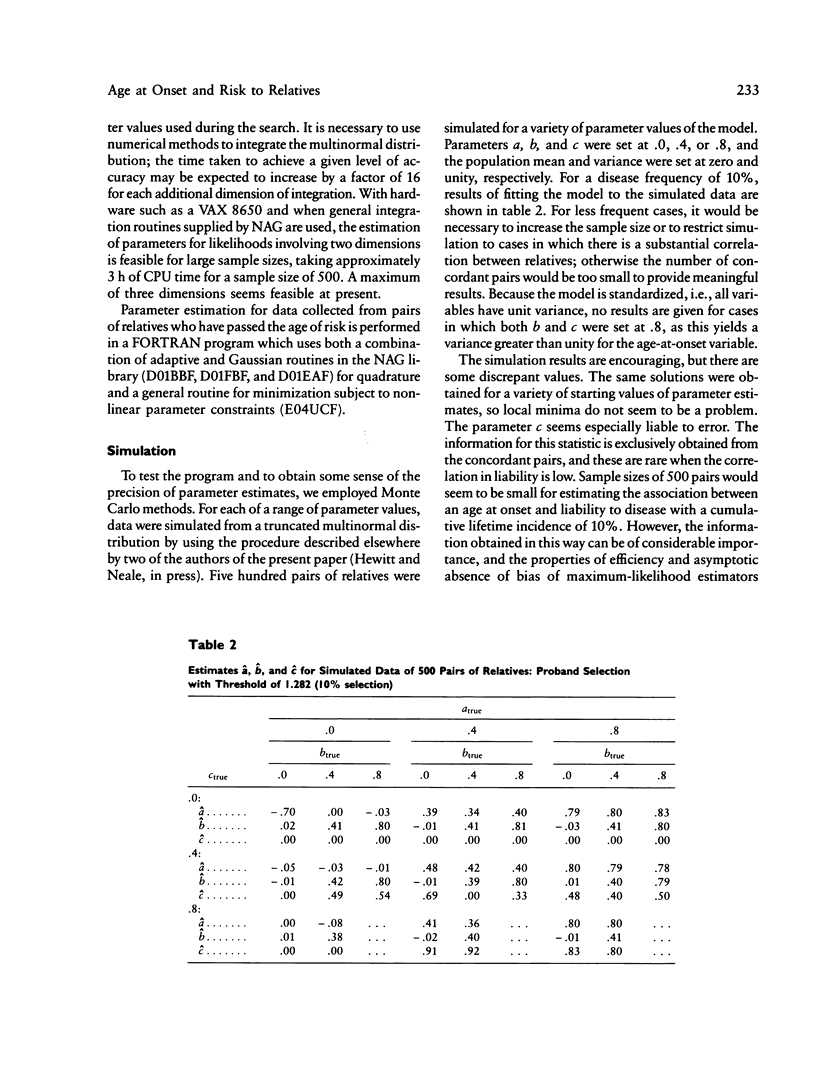
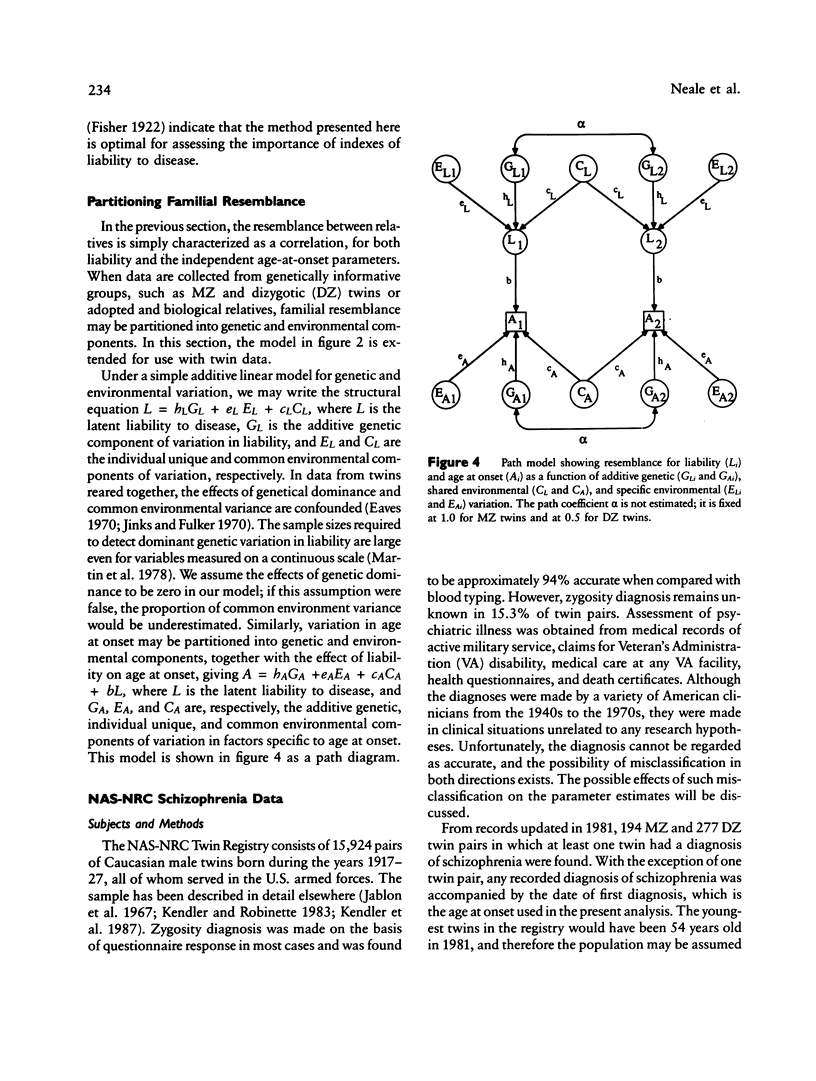
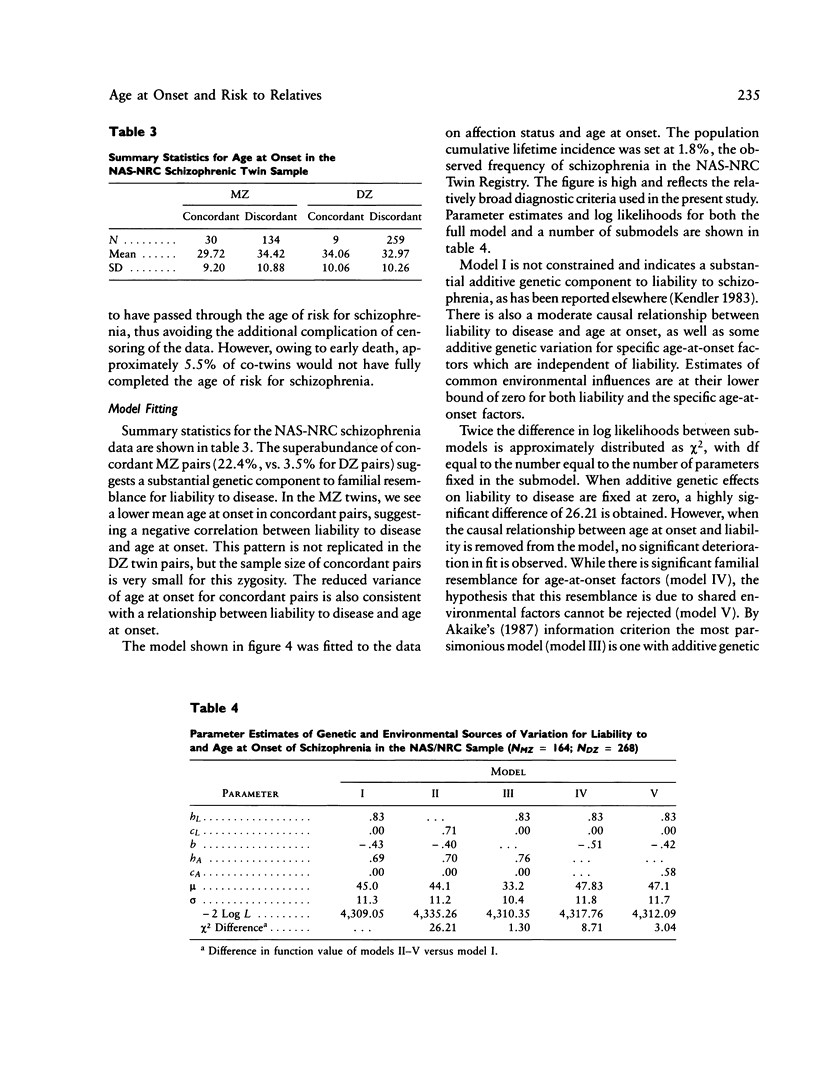
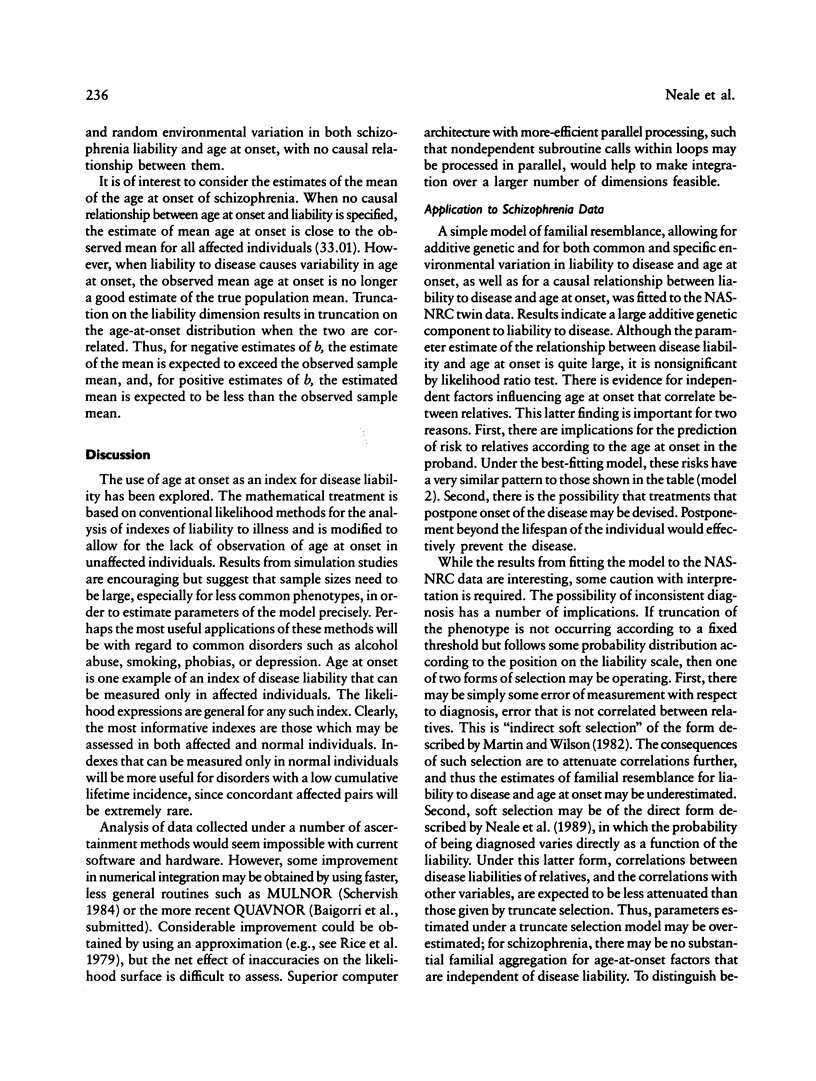
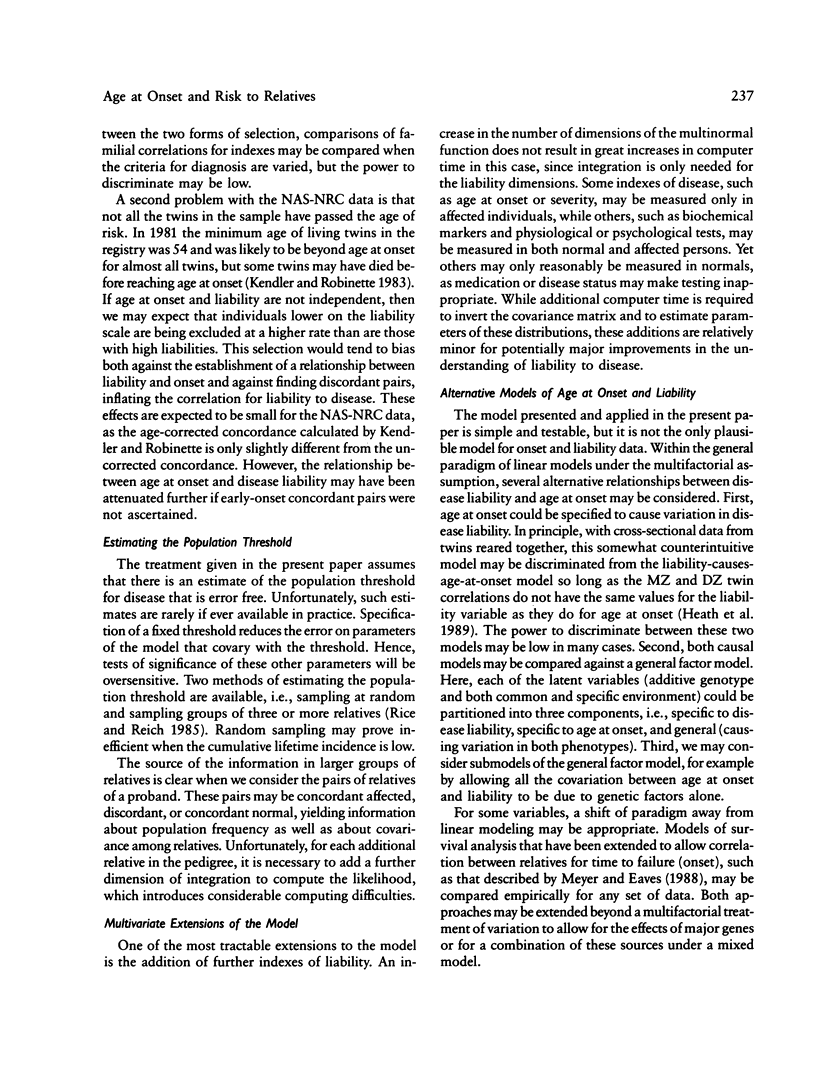
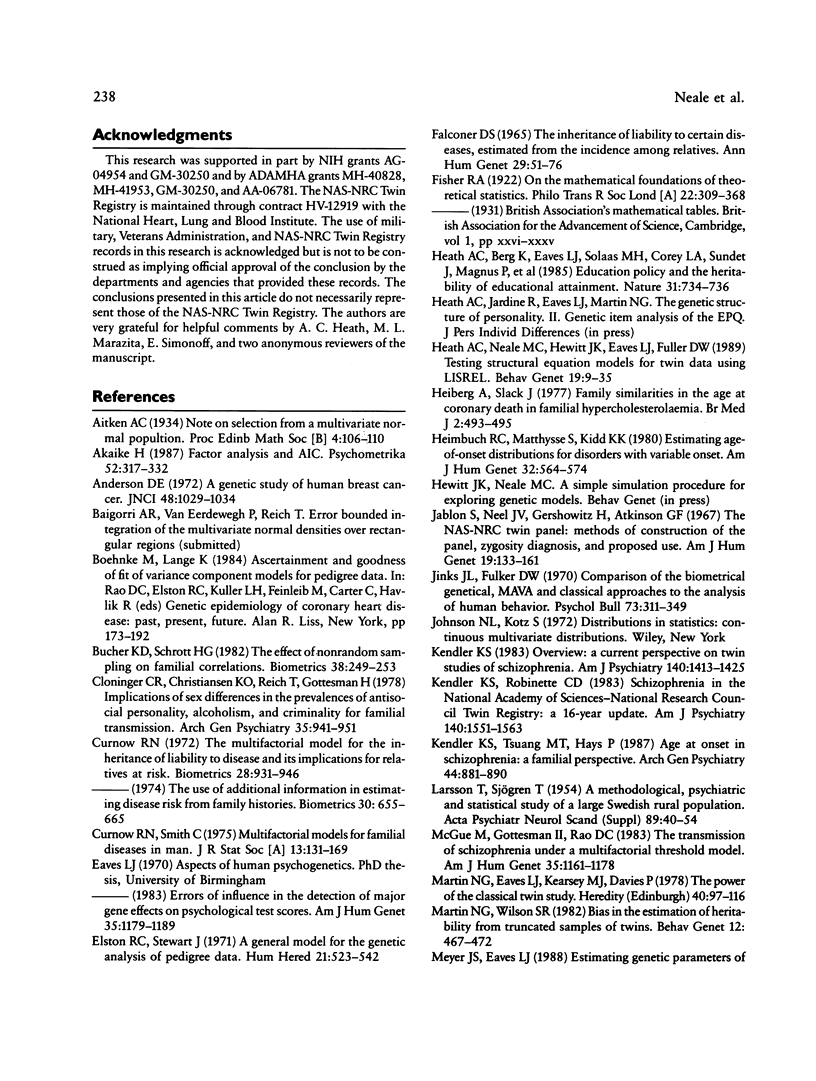
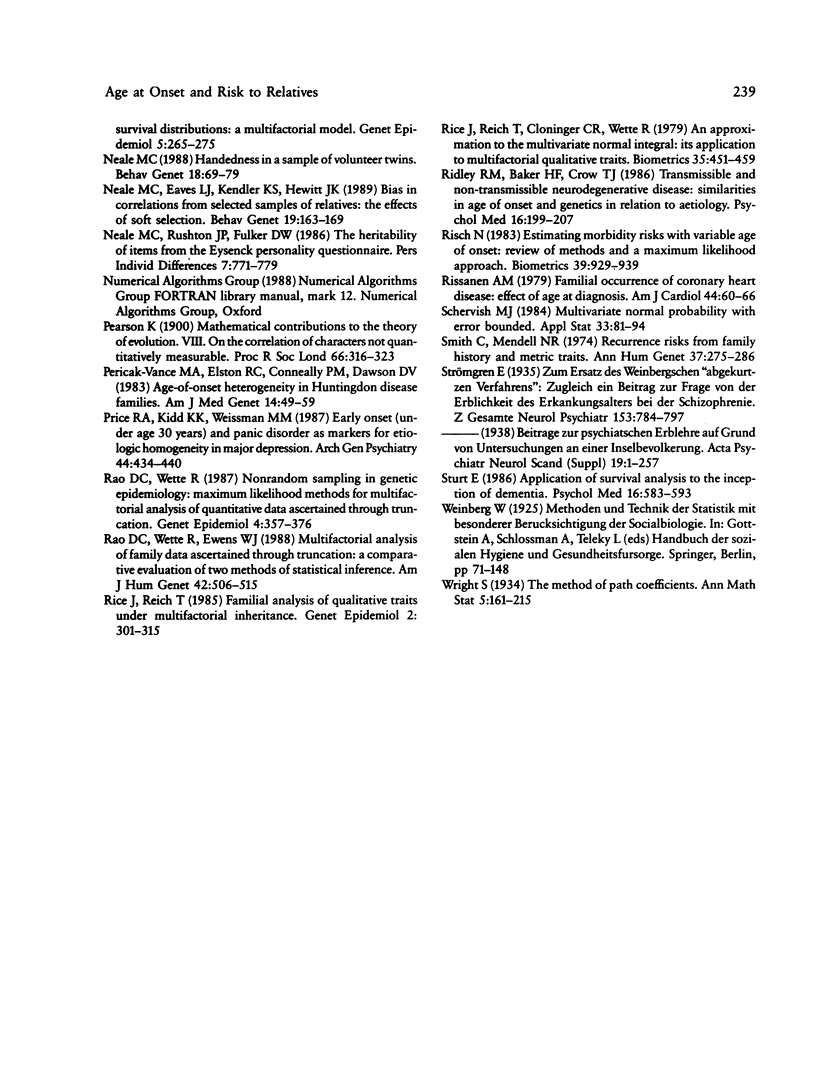
Selected References
These references are in PubMed. This may not be the complete list of references from this article.
- Anderson D. E. A genetic study of human breast cancer. J Natl Cancer Inst. 1972 Apr;48(4):1029–1034. [PubMed] [Google Scholar]
- Cloninger C. R., Christiansen K. O., Reich T., Gottesman I. I. Implications of sex differences in the prevalences of antisocial personality, alcoholism, and criminality for familial transmission. Arch Gen Psychiatry. 1978 Aug;35(8):941–951. doi: 10.1001/archpsyc.1978.01770320035002. [DOI] [PubMed] [Google Scholar]
- Curnow R. N. The multifactorial model for the inheritance of liability to disease and its implications for relatives at risk. Biometrics. 1972 Dec;28(4):931–946. [PubMed] [Google Scholar]
- Eaves L. J. Errors of inference in the detection of major gene effects on psychological test scores. Am J Hum Genet. 1983 Nov;35(6):1179–1189. [PMC free article] [PubMed] [Google Scholar]
- Elston R. C., Stewart J. A general model for the genetic analysis of pedigree data. Hum Hered. 1971;21(6):523–542. doi: 10.1159/000152448. [DOI] [PubMed] [Google Scholar]
- Heath A. C., Berg K., Eaves L. J., Solaas M. H., Corey L. A., Sundet J., Magnus P., Nance W. E. Education policy and the heritability of educational attainment. 1985 Apr 25-May 1Nature. 314(6013):734–736. doi: 10.1038/314734a0. [DOI] [PubMed] [Google Scholar]
- Heath A. C., Neale M. C., Hewitt J. K., Eaves L. J., Fulker D. W. Testing structural equation models for twin data using LISREL. Behav Genet. 1989 Jan;19(1):9–35. doi: 10.1007/BF01065881. [DOI] [PubMed] [Google Scholar]
- Heiberg A., Slack J. Family similarities in the age at coronary death in familial hypercholesterolaemia. Br Med J. 1977 Aug 20;2(6085):493–495. doi: 10.1136/bmj.2.6085.493. [DOI] [PMC free article] [PubMed] [Google Scholar]
- Heimbuch R. C., Matthysse S., Kidd K. K. Estimating age-of-onset distributions for disorders with variable onset. Am J Hum Genet. 1980 Jul;32(4):564–574. [PMC free article] [PubMed] [Google Scholar]
- Jablon S., Neel J. V., Gershowitz H., Atkinson G. F. The NAS-NRC twin panel: methods of construction of the panel, zygosity diagnosis, and proposed use. Am J Hum Genet. 1967 Mar;19(2):133–161. [PMC free article] [PubMed] [Google Scholar]
- Jinks J. L., Fulker D. W. Comparison of the biometrical genetical, MAVA, and classical approaches to the analysis of human behavior. Psychol Bull. 1970 May;73(5):311–349. doi: 10.1037/h0029135. [DOI] [PubMed] [Google Scholar]
- Kendler K. S., Robinette C. D. Schizophrenia in the National Academy of Sciences-National Research Council Twin Registry: a 16-year update. Am J Psychiatry. 1983 Dec;140(12):1551–1563. doi: 10.1176/ajp.140.12.1551. [DOI] [PubMed] [Google Scholar]
- Kendler K. S., Tsuang M. T., Hays P. Age at onset in schizophrenia. A familial perspective. Arch Gen Psychiatry. 1987 Oct;44(10):881–890. doi: 10.1001/archpsyc.1987.01800220047008. [DOI] [PubMed] [Google Scholar]
- Martin N. G., Eaves L. J., Kearsey M. J., Davies P. The power of the classical twin study. Heredity (Edinb) 1978 Feb;40(1):97–116. doi: 10.1038/hdy.1978.10. [DOI] [PubMed] [Google Scholar]
- Martin N. G., Wilson S. R. Bias in the estimation of heritability from truncated samples of twins. Behav Genet. 1982 Jul;12(4):467–472. doi: 10.1007/BF01065638. [DOI] [PubMed] [Google Scholar]
- McGue M., Gottesman I. I., Rao D. C. The transmission of schizophrenia under a multifactorial threshold model. Am J Hum Genet. 1983 Nov;35(6):1161–1178. [PMC free article] [PubMed] [Google Scholar]
- Meyer J. M., Eaves L. J. Estimating genetic parameters of survival distributions: a multifactorial model. Genet Epidemiol. 1988;5(4):265–275. doi: 10.1002/gepi.1370050408. [DOI] [PubMed] [Google Scholar]
- Neale M. C., Eaves L. J., Kendler K. S., Hewitt J. K. Bias in correlations from selected samples of relatives: the effects of soft selection. Behav Genet. 1989 Mar;19(2):163–169. doi: 10.1007/BF01065901. [DOI] [PubMed] [Google Scholar]
- Neale M. C. Handedness in a sample of volunteer twins. Behav Genet. 1988 Jan;18(1):69–79. doi: 10.1007/BF01067076. [DOI] [PubMed] [Google Scholar]
- Pericak-Vance M. A., Elston R. C., Conneally P. M., Dawson D. V. Age-of-onset heterogeneity in Huntington disease families. Am J Med Genet. 1983 Jan;14(1):49–59. doi: 10.1002/ajmg.1320140109. [DOI] [PubMed] [Google Scholar]
- Price R. A., Kidd K. K., Weissman M. M. Early onset (under age 30 years) and panic disorder as markers for etiologic homogeneity in major depression. Arch Gen Psychiatry. 1987 May;44(5):434–440. doi: 10.1001/archpsyc.1987.01800170048008. [DOI] [PubMed] [Google Scholar]
- Rao D. C., Wette R., Ewens W. J. Multifactorial analysis of family data ascertained through truncation: a comparative evaluation of two methods of statistical inference. Am J Hum Genet. 1988 Mar;42(3):506–515. [PMC free article] [PubMed] [Google Scholar]
- Rao D. C., Wette R. Nonrandom sampling in genetic epidemiology: maximum likelihood methods for multifactorial analysis of quantitative data ascertained through truncation. Genet Epidemiol. 1987;4(5):357–376. doi: 10.1002/gepi.1370040505. [DOI] [PubMed] [Google Scholar]
- Rice J., Reich T. Familial analysis of qualitative traits under multifactorial inheritance. Genet Epidemiol. 1985;2(3):301–315. doi: 10.1002/gepi.1370020307. [DOI] [PubMed] [Google Scholar]
- Ridley R. M., Baker H. F., Crow T. J. Transmissible and non-transmissible neurodegenerative disease: similarities in age of onset and genetics in relation to aetiology. Psychol Med. 1986 Feb;16(1):199–207. doi: 10.1017/s0033291700002634. [DOI] [PubMed] [Google Scholar]
- Risch N. Estimating morbidity risks with variable age of onset: review of methods and a maximum likelihood approach. Biometrics. 1983 Dec;39(4):929–939. [PubMed] [Google Scholar]
- Rissanen A. M. Familial occurrence of coronary heart disease: effect of age at diagnosis. Am J Cardiol. 1979 Jul;44(1):60–66. doi: 10.1016/0002-9149(79)90251-0. [DOI] [PubMed] [Google Scholar]
- Smith C., Mendell N. R. Recurrence risks from family history and metric traits. Ann Hum Genet. 1974 Jan;37(3):275–286. doi: 10.1111/j.1469-1809.1974.tb01835.x. [DOI] [PubMed] [Google Scholar]
- Sturt E. Application of survival analysis to the inception of dementia. Psychol Med. 1986 Aug;16(3):583–593. doi: 10.1017/s0033291700010345. [DOI] [PubMed] [Google Scholar]


